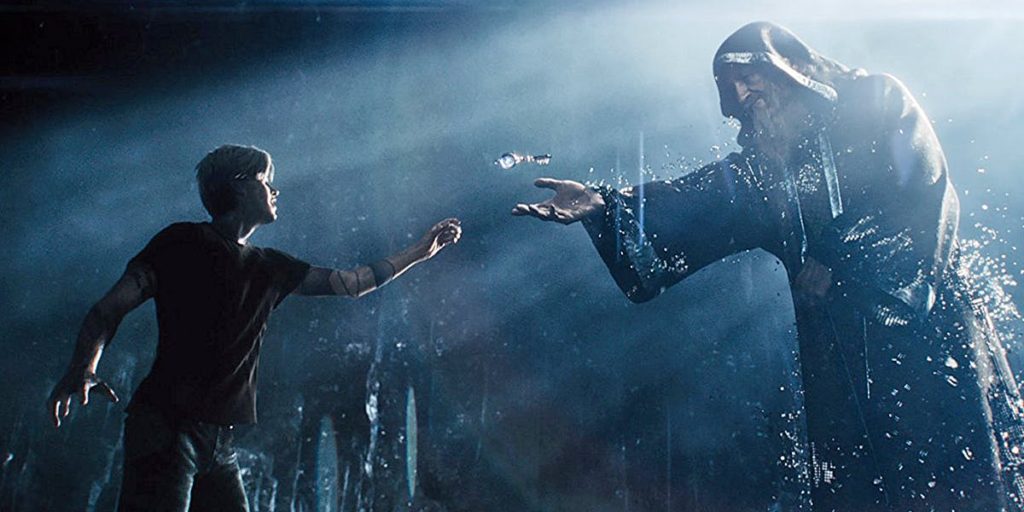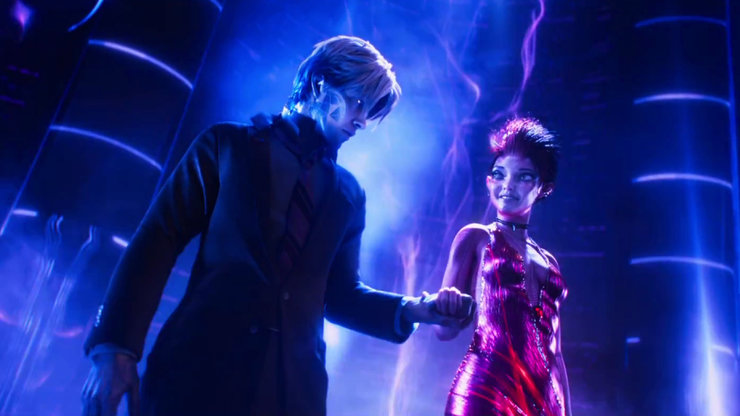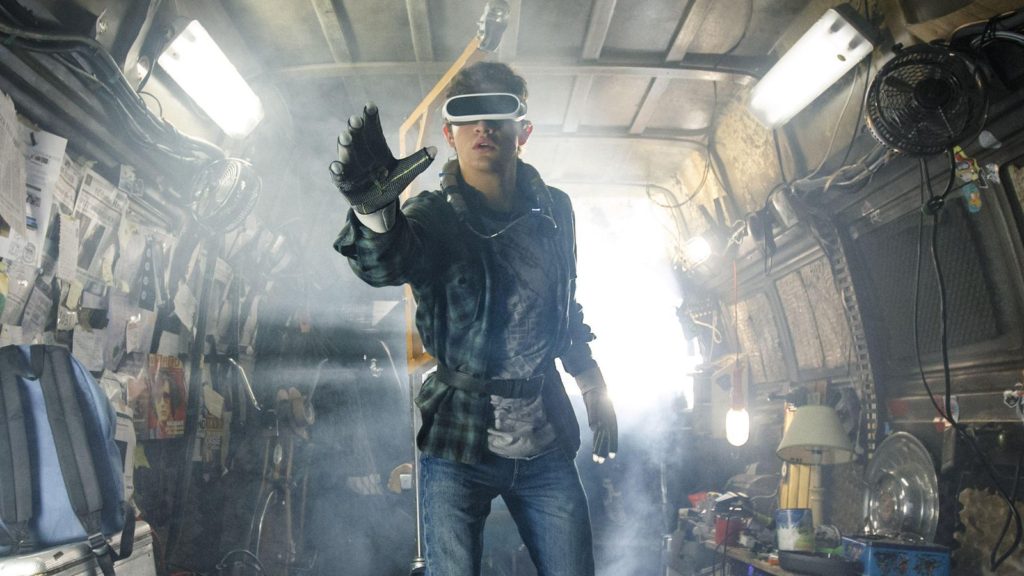Ready Player One (2018)
CAST: Tye Sheridan, Olivia Cooke, Ben Mendelsohn, Lena Waithe, Philip Zao, Win Morisaki, Hannah John-Kamen, Mark Rylance, T.J. Miller, Simon Pegg
REVIEW:
Ready Player One might be the biggest special effects extravaganza since James Cameron’s Avatar nearly a decade ago, and while it won’t necessarily go down as a classic on the level of Steven Spielberg’s most beloved films, it resurrects some of the old Spielbergian magic that many thought flickered out a long time ago (his last attempt at hearkening back to the lighthearted sense of fun he once possessed before Schindler’s List and Saving Private Ryan, 2008’s Indiana Jones and the Kingdom of the Crystal Skull, felt low energy and tired and only flirted with recapturing it in fits and starts). Many movies aspire to be referred to as “eye candy”, but it’s well-deserved here. Ready Player One might not be the most consequential movie Spielberg has directed in a long time, but it’s easily the most fun.
The basics will be familiar to fans of the source material, Ernest Cline’s novel of the same name, although Spielberg has made some deviations in adapting from page to screen (though Cline himself was likely involved, as he is credited as a screenwriter). For the uninitiated, we begin in 2045, where an increasingly dilapidated reality has led people to become obsessed with the escapism of the Oasis, a sprawling virtual reality universe where anyone with VR equipment can put on their visor and explore various fantastic worlds, take part in wild car races, dance in zero gravity nightclubs, and indulge whatever other fantasies their heart desires (though Spielberg keeps things PG-13), along with donning an in-game avatar that can look like any gender, species, or character they want. Wade Watts (Tye Sheridan) is one of millions who escapes from his unfulfilling real existence into the world(s) of the Oasis, and is among an elite of hardcore gamers called “Gunters” who are searching for the “Easter Egg” left behind by Oasis’ late creator James Halliday (Mark Rylance), the pot of gold at the end of a convoluted treasure hunt that will bequeath the winner half a trillion dollars and complete control over the Oasis itself. In the form of his in-game avatar, Parzival, Wade has befriended several other Gunters, including his best friend Aech (Lena Waithe), whom he’s never met in reality, and the samurai-inspired brother duo of Sho (Philip Zhao) and Daito (Win Morisaki), as well as his newest acquaintance, the alluring and bad-ass Art3mis (Olivia Cooke), with whom he becomes infatuated. But Wade and his cohorts are not the only ones seeking Halliday’s Easter Egg. So is corporate CEO Nolan Sorrento (Ben Mendelsohn), who plays dirty and has considerable resources at his disposal including an in-game henchman (T.J. Miller), a real-life henchwoman (Hannah John-Kamen), and a slave labor force of people whose debt has been taken over by his corporation and have become indentured servants whom he dispatches into the game in droves to find the Egg. When Wade/Parzival uncovers the first clue and gets closer to the Egg than anyone has ever come before, and also rejects Sorrento’s offer of an alliance, the stakes kick up a notch as Sorrento and his cronies uncover his real identity and target both Parzival within the game and Wade in the real world.
 Despite some moments of tension, especially after Wade realizes he’s in flesh-and-blood danger in real life, Ready Player One maintains a predominantly fairly lighthearted tone and plenty of quirky humor, including some of the satirical variety (Sorrento cheerfully boasts to his company board that once control of the Oasis is theirs and Halliday’s ad restrictions have been removed, “we can sell up to 80% of a user’s visual field before inducing seizures”). The Oasis is a fascinating place to visit, the kind of eye candy where there’s so much whizzing by that we wish at times that we could slow down and explore more of it. Perhaps inevitably, most or all of the most memorable sequences take place within Oasis, including a wild opening car race where the cars have to evade, among other things, the T-Rex from Jurassic Park and King Kong. Later, there’s a Saturday Night Fever homage involving a delightful zero gravity nightclub dance number (yes, set to “Stayin’ Alive”) that’s both visually wondrous and fun and flirty on a character level. And one of the levels seeking the Easter Egg forces our band to navigate the Overlook Hotel from The Shining, the recreation of which is eerily spot-on (there’s even the creepy twin girls, the lobby flooding with blood, the snowy hedgerow maze, and axes smashing through doors). Like the book, the movie is gleefully steeped in ’80s pop culture and video gamer culture, and part of the fun is spotting all the “Easter Eggs”. Parzival drives the Delorean from Back to the Future, and a device that enables the bearer to travel backward in time is nicknamed a “Zemeckis Cube” (an in-joke referencing, of course, Back to the Future‘s director Robert Zemeckis). King Kong, MechaGodzilla, and Iron Giant are prominently featured, and Gundam, Minecraft, Halo, Batman, Freddy Krueger, Jason, the chestburster from Alien, the Teenage Mutant Ninja Turtles, Beetlejuice, The Joker and Harley Quinn, the 1960s Batmobile, and the killer doll Chucky all make cameos, some of which you have to keep a sharp watch for (Chucky’s cameo gets some of the biggest laughs and also involves the movie’s sole, well-placed F-bomb). Superman doesn’t show up, but for those who always rolled their eyes at how Clark Kent’s glasses somehow made him unrecognizable to all around him, the movie makes an amusing joke at their expense. The busy soundtrack ticks off ’70s and ’80s hits like Van Halen’s “Jump”, the Bee Gees’ “Stayin’ Alive”, Joan Jett’s “I Hate Myself For Loving You”, Twisted Sister’s “We’re Not Gonna Take It”, Blondie’s “One Way or Another”, and Hall & Oates’ “You Make My Dreams Come True”, accentuating the wave of nostalgia. Oddly enough, Spielberg doesn’t delve back through his own extensive filmography apart from a brief cameo from Jurassic Park‘s T-Rex. The movie is also a love letter to the “purity” of true passionate gamers like Wade (and Halliday himself) who love the Oasis as a symbol of freedom and escapism versus cynical posers like Sorrento who can behold all the wonders of the Oasis and see nothing but dollar signs; this leads to an amusing scene in which Sorrento tries to seduce Wade into an alliance by “bonding” with the boy with shared nerdy pop culture trivia his team of analysts are feeding into his earpiece. Ready Player One is meant to be crowd-pleasing and entertaining for mainstream general audiences, but it’s an unabashedly nerdy movie that proudly wears it on its sleeve; one doesn’t have to be steeped in ’80s pop culture or an avid video gamer to enjoy themselves, but it undoubtedly will kick one’s appreciation up a notch.
Despite some moments of tension, especially after Wade realizes he’s in flesh-and-blood danger in real life, Ready Player One maintains a predominantly fairly lighthearted tone and plenty of quirky humor, including some of the satirical variety (Sorrento cheerfully boasts to his company board that once control of the Oasis is theirs and Halliday’s ad restrictions have been removed, “we can sell up to 80% of a user’s visual field before inducing seizures”). The Oasis is a fascinating place to visit, the kind of eye candy where there’s so much whizzing by that we wish at times that we could slow down and explore more of it. Perhaps inevitably, most or all of the most memorable sequences take place within Oasis, including a wild opening car race where the cars have to evade, among other things, the T-Rex from Jurassic Park and King Kong. Later, there’s a Saturday Night Fever homage involving a delightful zero gravity nightclub dance number (yes, set to “Stayin’ Alive”) that’s both visually wondrous and fun and flirty on a character level. And one of the levels seeking the Easter Egg forces our band to navigate the Overlook Hotel from The Shining, the recreation of which is eerily spot-on (there’s even the creepy twin girls, the lobby flooding with blood, the snowy hedgerow maze, and axes smashing through doors). Like the book, the movie is gleefully steeped in ’80s pop culture and video gamer culture, and part of the fun is spotting all the “Easter Eggs”. Parzival drives the Delorean from Back to the Future, and a device that enables the bearer to travel backward in time is nicknamed a “Zemeckis Cube” (an in-joke referencing, of course, Back to the Future‘s director Robert Zemeckis). King Kong, MechaGodzilla, and Iron Giant are prominently featured, and Gundam, Minecraft, Halo, Batman, Freddy Krueger, Jason, the chestburster from Alien, the Teenage Mutant Ninja Turtles, Beetlejuice, The Joker and Harley Quinn, the 1960s Batmobile, and the killer doll Chucky all make cameos, some of which you have to keep a sharp watch for (Chucky’s cameo gets some of the biggest laughs and also involves the movie’s sole, well-placed F-bomb). Superman doesn’t show up, but for those who always rolled their eyes at how Clark Kent’s glasses somehow made him unrecognizable to all around him, the movie makes an amusing joke at their expense. The busy soundtrack ticks off ’70s and ’80s hits like Van Halen’s “Jump”, the Bee Gees’ “Stayin’ Alive”, Joan Jett’s “I Hate Myself For Loving You”, Twisted Sister’s “We’re Not Gonna Take It”, Blondie’s “One Way or Another”, and Hall & Oates’ “You Make My Dreams Come True”, accentuating the wave of nostalgia. Oddly enough, Spielberg doesn’t delve back through his own extensive filmography apart from a brief cameo from Jurassic Park‘s T-Rex. The movie is also a love letter to the “purity” of true passionate gamers like Wade (and Halliday himself) who love the Oasis as a symbol of freedom and escapism versus cynical posers like Sorrento who can behold all the wonders of the Oasis and see nothing but dollar signs; this leads to an amusing scene in which Sorrento tries to seduce Wade into an alliance by “bonding” with the boy with shared nerdy pop culture trivia his team of analysts are feeding into his earpiece. Ready Player One is meant to be crowd-pleasing and entertaining for mainstream general audiences, but it’s an unabashedly nerdy movie that proudly wears it on its sleeve; one doesn’t have to be steeped in ’80s pop culture or an avid video gamer to enjoy themselves, but it undoubtedly will kick one’s appreciation up a notch.
 This might be the biggest special effects extravaganza since James Cameron’s Avatar nearly a decade ago, and while the two films’ plots have little in common, there are a couple superficial similarities including the futuristic setting and the fact that, as in Avatar, the main characters spend sizable chunks of screentime in different bodies, albeit virtual reality rather than actual flesh-and-blood (with the cast doing double duty showing their own faces in reality and performing their CGI in-game avatars via motion capture). Tye Sheridan’s Wade and Olivia Cooke’s Samantha aren’t unattractive (Wade is described as nerdy and overweight in the book, but as is often the case, this has been downplayed in the movie), but they’re average, ordinary-looking people, while in the game, as “Parzival” and “Art3mis”, they’re hyper-stylized into video game characters with elfin features, big luminous eyes, colorful hair, and flamboyant wardrobes. Likewise, within the game, scrawny weaselly Ben Mendelsohn is souped-up into a square-jawed, hulking version of himself that looks like an evil corporate Superman (right down to the spit curl). Mark Rylance’s Halliday, as “Anorak”, has the deliberately stereotypical image of an elderly bearded wizard in hooded cloak.
This might be the biggest special effects extravaganza since James Cameron’s Avatar nearly a decade ago, and while the two films’ plots have little in common, there are a couple superficial similarities including the futuristic setting and the fact that, as in Avatar, the main characters spend sizable chunks of screentime in different bodies, albeit virtual reality rather than actual flesh-and-blood (with the cast doing double duty showing their own faces in reality and performing their CGI in-game avatars via motion capture). Tye Sheridan’s Wade and Olivia Cooke’s Samantha aren’t unattractive (Wade is described as nerdy and overweight in the book, but as is often the case, this has been downplayed in the movie), but they’re average, ordinary-looking people, while in the game, as “Parzival” and “Art3mis”, they’re hyper-stylized into video game characters with elfin features, big luminous eyes, colorful hair, and flamboyant wardrobes. Likewise, within the game, scrawny weaselly Ben Mendelsohn is souped-up into a square-jawed, hulking version of himself that looks like an evil corporate Superman (right down to the spit curl). Mark Rylance’s Halliday, as “Anorak”, has the deliberately stereotypical image of an elderly bearded wizard in hooded cloak.
While the visual effects extravaganza undeniably is the biggest selling point, the narrative is fast-paced and engaging, if not groundbreaking, with a few twists and turns. Wade/Parzival and his merry band are likable, both “in the flesh” and in their Oasis alter egos (which, at least until the third act, is how we spend more time with them). The treasure hunt is engaging, as Wade and company uncover clues and riddles scattered through Halliday’s meticulously documented life story (served up as scattered flashbacks viewed by the characters as video recordings), which eventually leads to a poignant revelation or two. While this isn’t an actors’ movie, there’s enough chemistry between Tye Sheridan and Olivia Cooke to sell their budding romance, though it’s a while before they actually meet “in the flesh”. Art3mis is the most captivating CGI heroine since Avatar‘s Neytiri, but while her looks might be more average as Samantha, she loses none of her spunk, and the “click” carries over between the early fun and flirty in-game interactions between Parzival/Art3mis, and when they eventually come face to face as Wade and Samantha, which makes them an appealing couple. Ben Mendelsohn, who’s obviously becoming one of Hollywood’s latest go-to “bad guy” actors after The Dark Knight Rises, Exodus, and Rogue One, basically reprises his hammy corporate weasel from The Dark Knight Rises (one could easily imagine him in some ’80s movie about a gang of plucky kids thwarting the cartoonishly mustache-twirling businessman who wants to demolish their park and build a shopping mall, or something). Sorrento is not the strongest of villains—in fact, one could argue Hannah John-Kamen as his steely-eyed henchwoman (who bears a suspicious resemblance to Sylvia Hoeks’ Luv from Blade Runner 2049) is nastier than he is—but the subplot involving Sorrento and minions is basically just a plot device to help drive the action. T.J. Miller (the only Oasis character who never shows his real face) and Lena Waithe (as Wade’s in-game best friend who’s not what he might have expected in reality) supply some comic relief. Mark Rylance (who’s becoming something of a Spielberg regular between Bridge of Spies, BFG, and now this) is dead before the movie begins but still gets a fair amount of screentime via flashbacks and recordings, with Simon Pegg as his business partner.
As much fun as Ready Player One might be, it’s not perfect. The movie serves up its best Oasis-based sequences—the car chase, the nightclub dance, and the eerily spot-on recreation of The Shining—before we get to the end, where we cap things off with a generic climactic CGI-oversaturated battle royale, though there’s still fun to be had by playing “spot the cameo” as Spielberg throws the kitchen sink at the screen in massive armies populated with pop culture icons colliding, and the tension is bumped up a notch by the action cross-cutting between the battle within the game and Wade and friends in danger in reality. The movie decidedly puts out some “trying to have its cake and eat it too” mixed messages by handing down a closing moral about the importance of stepping away from the game and living life in reality that feels a little hollow after the previous two plus hours of gleefully reveling in the Oasis’ orgiastic excess. The fact that Tye Sheridan spends as much or more time providing motion capture for a CGI alter ego than he does with his real face onscreen might be a hindrance for some who connect more with a flesh-and-blood actor than with a CGI character (and the scales are tipped even further in favor of their in-game avatars when it comes to Olivia Cooke and the supporting players), though whether or not you found this to be a problem for you in Avatar is a good barometer for how you’ll feel about it here. Character development is sketchy (we get perfunctory backstories for Wade and Samantha) and some interesting aspects of the movie’s world are underexplored (like the indebted slave labor force employed as Sorrento’s in-game cannon fodder).
But while Ready Player One might not be a “great” movie in the true sense, it’s one of the most visually ambitious movies to come along within the last decade, a blast of gleefully geeky, energetic, crowd-pleasing escapist fun infused with a nostalgic treasure trove of ’80s pop culture and video gamer shout-outs, and a forceful piece of evidence that the escapist family fun which Steven Spielberg once churned out is still capable of resurfacing with the right material. Ready Player One is a blast, and a spectacle that demands to be blown up large on a theater screen.
* * * 1/2
